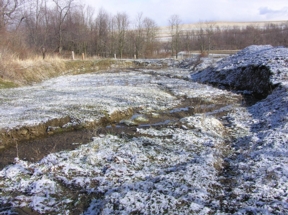Riparian Restoration and Protection Initiative
The Riparian Restoration and Protection Initiative (RRPI) was developed
to improve water quality and wildlife habitat by excluding livestock
from riparian areas. Livestock can trample stream banks, causing
accelerated erosion and high sediment loads, which deplete needed
stream side vegetation and loosen soil. Sediment can then enter the
stream and have detrimental impacts on aquatic life and important
related habitat. According to the Pennsylvania Department of
Environmental Protection (DEP), sediment causes the most water
pollution in Pennsylvania. Limiting livestock access to stream banks
has proven to be one of the best ways for a conservation-minded
agriculturalist to prevent erosion and loss of productive land, as well
as reduce nutrient runoff into the water. Stream bank fencing also
allows vegetation to reestablish itself in riparian areas, thereby
creating habitat for wildlife and providing shade for the stream.
In 2005, Western Pennsylvania Conservancy (WPC) and the Sewickley Creek
Watershed Association (SCWA) partnered to implement a DEP Growing Grant
for stream bank fencing projects in the Sewickley Creek watershed.
Funds from this grant have been coupled with federal funding programs
to stretch the money further. Federal conservation programs used
include the Continuous Conservation Reserve Program (CCRP), the
Conservation Reserve Enhancement Program (CREP), the Environmental
Quality Incentives Program (EQIP), and the Wildlife Habitat Incentives
Program (WHIP). The construction crew, California University Partners
for Fish and Wildlife (CUP Partners), also contributes a cost-share to
fencing costs.
Eight landowners have shown an interest in participating in this stream
bank-fencing program. Thus far, two farms have had fencing completed,
with a total of 2,208 feet of fence and two agricultural stream
crossings have been constructed. Funding for these farms included
SCWA’s Growing Greener grant, CUP Partners cost-share, and CCRP. The
remaining landowners would construct an estimated 17,410 feet of fence
and six agricultural stream crossings. Many of these landowners have
signed-up for the CREP program. SCWA funds will be used to complement
where CREP funding will not be used.




